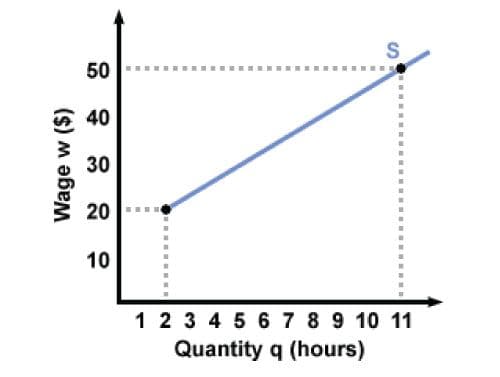Economists graphically represent the relationship between product price and quantity supplied with a supply curve. Typically, supply curves are upward-sloping, because as price increases, sellers are more likely to be willing to sell something. For instance, if someone offered you $10 for one of your favorite shirts, you might not want to part with it, since it wouldn't be worth it. However, if someone offered you $500 for that same shirt, you would most likely take the deal. Each individual seller can have their own supply curve, showing how many products they are willing to sell at any given price, as shown below. This graph shows what James's supply curve for hours of tutoring in economics might be.

To find out how many hours of tutoring James will supply for a given wage (when we put a price on hours of work, we call it a wage), extend a straight line from the price on the vertical axis to the supply curve. From the point of intersection, extend a line from the supply curve down to the quantity axis. The point where that vertical line meets the quantity axis indicates how many hours of tutoring James will provide. For instance, the graph above indicates that James will teach for 3 hours when the hourly wage is $30 an hour.
Economists don't spend a lot of time looking at individual supply curves. Instead, they look at market supply, the combined quantities supplied by all potential sellers. To do this, use the horizontal addition method, just as we do to find market demand. For instance, if James and Ina are the only two tutors in the market for economics tutoring, we would add how many hours they are willing to tutor at wage w=$20 and record that as the market demand for w=$20. Then we total up how many they are willing to tutor at wage w=$30 and record that as the market demand for w=$30, and so on. Combining the two supply curves in the first graph results in the market supply curve in the second graph:


Since at w = $20 James is unwilling to work and Ina is willing to work 2 hours, at w = $20 the market quantity supplied is 2 hours. At w = $50, James is willing to work 5 hours and Ina 6, so at w = $20 the market quantity supplied is 11 hours.
As with demand curves, so with supply curves movement can occur along the curve, or it can occur because of a curve shift. Movements along a fixed supply curve occur when nothing is changing except for the price of the good, so the only thing influencing the quantity supplied is a change in price. James and Ina, for example, together supply more tutoring hours as the hourly wage goes up, fewer as it goes down.
The other way supply quantity can change is through shifts in the supply curve. Recall that shifts in demand curves are caused by changes in income or changes in preferences. Supply curves can be affected by changes in profitability. This is most easily thought of in terms of changes in the costs of production inputs. For instance, if a bookstore buys a used book for $1 and sells it for $5, their profit is $4. Changes in the selling price of the book can change how many books they are willing to sell, and such changes would be represented by sliding up and down the same supply curve, as in the previous example. If the price the bookstore has to pay for the book changes, however, that would cause their supply curve to shift, even if the selling price doesn't change. If they have to pay more for the books they sell, their profitability drops, and make them less willing to sell books at prices they were willing to sell at before the change. We can see this below:

Notice that for any given price, the store will sell fewer books than before, reflecting higher costs and lower profits for each book. Thus, changes in profits can shift a firm's supply curve, even if the market price stays constant. We will later learn how to graphically visualize a firm's profits in a given market by using their different costs, sources of income, and the market price and demand.













